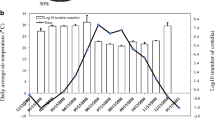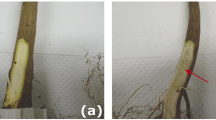Abstract.
Cytospora kunzei was detected on Pinus elderica at the plantation of Besni-Beskoz in Adiyaman, Turkey between 1999 and 2002. This is the first record of C. kunzei on P. elderica. Infections were evident on a number of trees when first detected in the beginning of April 1999, but rapidly increased during spring and early summer throughout 1999 and 2000. After 2001, disease development began to decrease, and many moderately and slightly infected trees recovered from this infection by producing healthy young shoots. However, disease development continued on some trees during 2001 and 2002. The percentage of infected trees was 40.1% in 1999, 63.2% in 2000 and 7.9% in 2001; disease severity was 7.5% in 1999 and 15.4% in 2000. No tree mortality occurred during 1999, but 0.6% of the trees were killed in the second year. Disease development, based on infection rates at four different intervals was r 2 = 0.999 in 1999 and r 2 =0.944 in 2000. C. kunzei was isolated from tissue adjacent to cankers on diseased trees and inoculation tests indicated that trees were more predisposed to canker development in 1999 and 2000 compared with 2001. Low rainfall, high temperature and their combined effect during 1999 and 2000 were probably the main stresses predisposing the trees to this pathogen and favouring the development of this epidemic.
Similar content being viewed by others
References
Anonymous (2001) ‘Records of Adiyaman Meteorological Stations.’ (State Meteorological Institute: Ankara, Turkey)
Banko TI, Helton AW (1974) Cytospora induced changes in stems of Prunus persica. Phytopathology64, 899–901.
Bertrand PF, English H (1976a) Release and dispersal of conidia and ascospores of Valsa leucostoma. Phytopathology66, 987–991.
Bertrand PF, English H (1976b) Virulence and seasonal activity of Cytospora leucostoma and C. cincta in French prune trees in California. Plant Disease Reporter60, 106–110.
Bier JE (1959b) The relation of bark moisture to the development of canker diseases caused by native, facultative parasites. Fusarium canker on black cottonwood. Canadian Journal of Botany37, 781–788.
Bier JE (1959b) The relation of bark moisture to the development of canker diseases caused by native, facultative parasites. Cephalosporium canker of western hemlock. Canadian Journal of Botany37, 1140–1142.
Blomberg WJ (1962) Cytospora canker on poplar. Canadian Journal of Botany40, 1271–1292.
Hawksworth FG, Hinds TE (1965) Cytospora canker of Engelmann spruce in Colorado. Plant Disease Reporter49, 72.
Helton AW, Moisey JA (1955) Cytospora damage in Idaho prune orchards. Plant Disease Reporter39, 931–943.
Hinds TE, Stewart JL (1965) Cytospora canker recurrence on Douglas fir in Colorado. Plant Disease Reporter49, 481–482.
Jorgensen E, Cafley JD (1961) Branch and stem cankers of white and Norway spruce in Ontario. Forestry Chronicle37, 394–400.
Kamiri LK, Laemmlen FF (1981a) Epidemiology of Cytospora canker caused in Colorado blue spruce by Valsa kunzei. Phytopathology71, 941–947.
Kamiri LK, Laemmlen FF (1981a) Effects of drought stress and wounding on Cytospora canker development on Colorado blue spruce. Journal of Arboriculture7, 113–116.
Kiraly Z (1977) ‘Current topics in plant pathology.’ (Academia Kiado: Budapest) Leupschen NS, Rohrbach KG (1969) Cytospora canker of peach trees: spore availability and wound susceptibility. Plant Disease Reporter53, 869–872.
Marsden DH (1948) A Valsa associated with Cytospora canker of spruces. Phytopathology38, 307–308.
Proffer TJ, Hart JH (1994) Wound inoculations of Colorado blue spruce with isolates of Leucostoma (Cytospora) kunzei and other Cytospora species. Journal of Arboriculture20, 215–221.
Rozsnyay ZSD (1977) Cytospora canker and dieback of Apricots. Rozsnyay ZSD, Klement Z (1973) Cytosporal die-back and simultaneous infection of Pseudomonas syringae and Cytospora cincta on apricots. Acta Phytopathology8, 57–69.
Schoeneweiss DF (1983) Drought predisposition to Cytospora canker in blue spruce. Plant Disease67, 383–385.
Snedecor GW, Cochran WG (1989) ‘Nonlinear relations. Statistical methods.’ 8th edn. (Iowa State University Press: Ames, Iowa)
Speilman LJ (1985) A monograph of Valsa on hardwoods in North America. Canadian Journal of Botany63, 1355–1378.
Stanova M (1970) Parasitism and pathogenic activity of Cytospora cincta Sacc. on Prunus armenica L. and Prunuspersica (L) Batsch. Biologia25, 445–451 [Bratislava].
Van Der Plank JE (1963) ‘Plant diseases: epidemics and control.’ (Academic Press: London)
Waterman AM (1955) The relation of Valsa kunzei to cankers on conifers. Phytopathology45, 686–692.
Author information
Authors and Affiliations
Corresponding author
Rights and permissions
About this article
Cite this article
Kavak, H. Cytospora kunzei on plantation-grown Pinus elderica in Turkey. Australasian Plant Pathology 34, 151–156 (2005). https://doi.org/10.1071/AP05006
Received:
Accepted:
Published:
Issue Date:
DOI: https://doi.org/10.1071/AP05006




